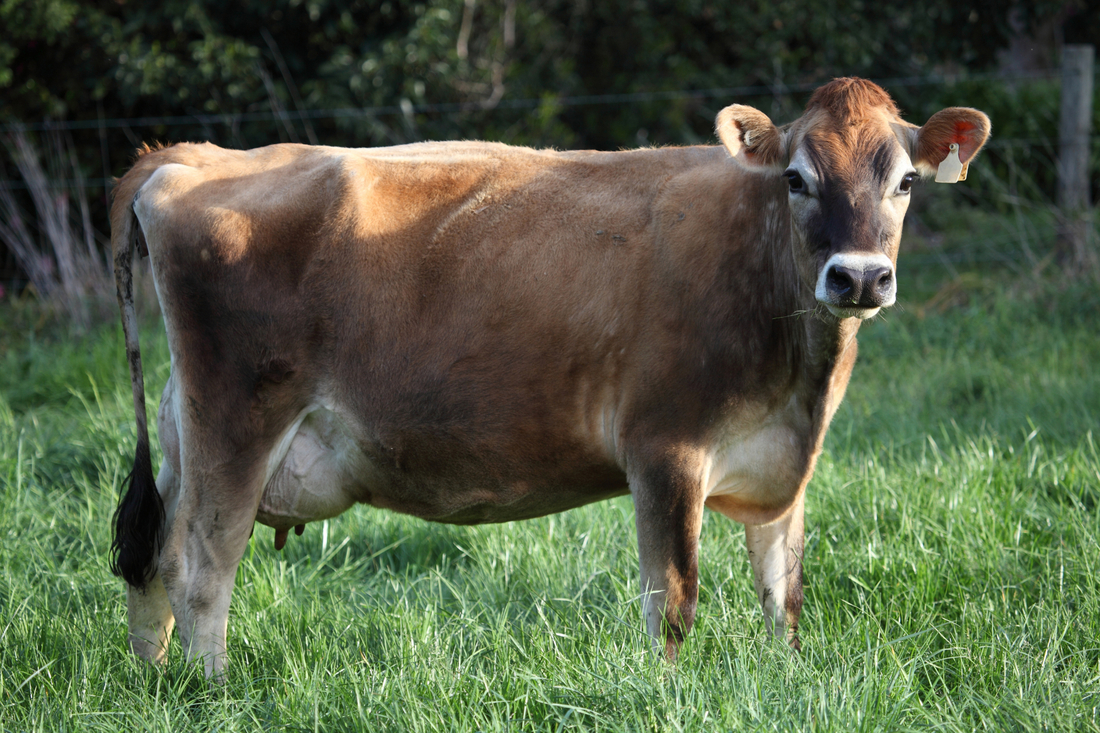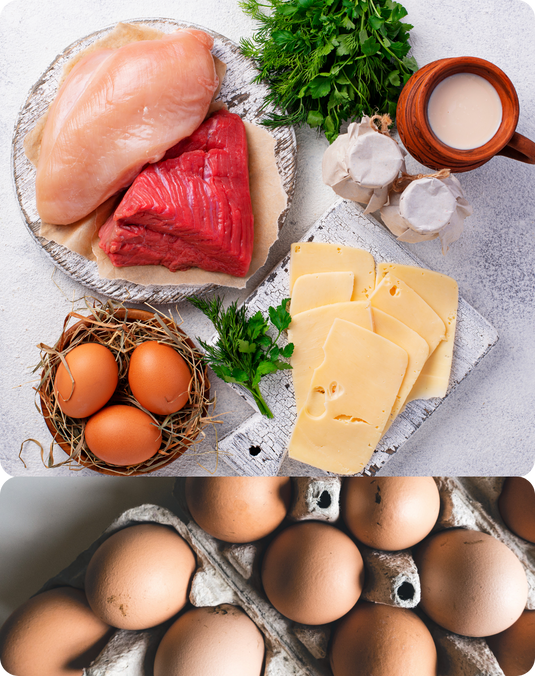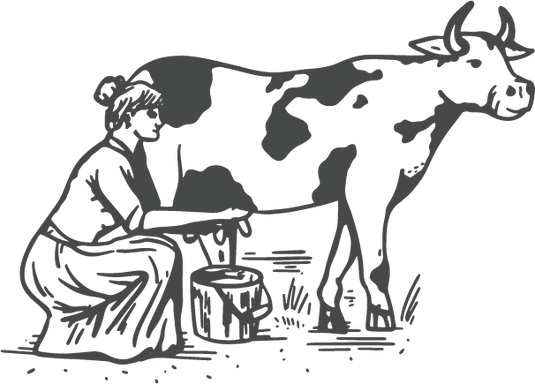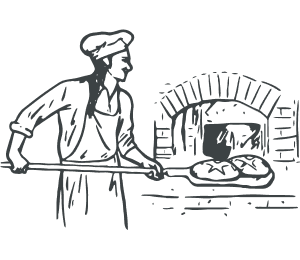


1. 100% Grass-Fed and Rotationally Grazed
The cows at our partner farms are never confined and never fed grain, spending their days grazing freely on lush, regenerative pastures: just as wild ruminants do. This allows them to express natural behaviors, roam in fresh air and abundant sunshine, and maintain a deep connection to the land. In the mornings and evenings, they return to the milking parlor, where they briefly step onto the milking stand before heading back out to pasture.
Our farm partners implement regenerative rotational grazing, moving sheep to fresh pasture daily while allowing previously grazed areas to recover. This method mimics natural flock movements and brings profound environmental benefits:
- Enhanced soil health and fertility
- Increased biodiversity in grass species and soil microbiome
- Improved carbon and water cycles
- Reduced parasite exposure
- Enhanced nutrient density in the final product
Unlike continuous grazing (where animals remain in one area too long, leading to overgrazing and soil depletion) this approach creates a self-sustaining cycle. Cows graze intensively for a short period, then move on, allowing plants to fully regenerate. The result? Healthier land, richer forage, more resilient animals, and superior-quality meat and dairy.
When pastures become dormant in winter, our farm partner provides only chemical-free, high-quality hay that is produced on the farm or sourced from approved locations. This ensures the cows continue receiving clean, nutrient-rich forage, maintaining peak health even in cold months. In extreme weather conditions, cows are provided with shelter for safety and straw bedding to keep them warm and comfortable.

2. Superior Nutrient Profile, No Fatty Acid Manipulation
Our farm partners never feed grain, oilseeds, or use rumen bypass methods to manipulate fatty acid composition: ensuring that our cow milk and dairy products retain their natural fat profile, just as nature intended.
Grain feeding introduces several concerns:
- Grains and distiller grains contain endocrine-disrupting phytoestrogens and pesticide residues that can disrupt hormone balance.
- Grain feeding increases Polyunsaturated Fatty Acid (PUFA) levels while reducing beneficial saturated fats, which can negatively impact metabolism.
Our commitment to the Nourish Promise LowPs™ standard means our cow dairy remains naturally low in PUFAs, phytoestrogens, and pesticides, delivering superior nutrition and metabolic health benefits.
Since the dairy cows are rotationally grazed on diverse pastures, their milk not only contains more vitamins and minerals, but it's also rich in beneficial phytochemicals, naturally occurring plant compounds with numerous health benefits. Terpenoids provide anti-inflammatory, anti-viral, and anti-carcinogenic properties, while polyphenols protect against cancer, cardiovascular disease, and diabetes, supporting immune function and gut health.
Rotationally grazed cows consume a wide variety of forages, each contributing unique phytochemicals. Research shows these compounds transfer directly into the milk, enhancing both nutritional value and flavor. Feedlot grain-fed cows consume virtually none of these beneficial compounds, while continuously grazed cows on a single pasture access far fewer plant varieties. This is why truly regenerative, grass-fed cow dairy is not only healthier: it also delivers the distinctive, rich flavor that only comes from a diverse, pasture-based diet.

3. Sanitary milking conditions
A common misconception is that raw milk inherently contains harmful bacteria. In reality, contamination only occurs after the milk leaves the teats, and this happens solely due to unsanitary milking conditions. To uphold the highest standards of cleanliness and safety, our farm partner follows strict milking protocols.
Each morning and evening, the cows are brought in from pasture for milking. The milking equipment is meticulously sanitized with hot water and diluted hydrogen peroxide, and the milking area is diligently maintained for optimal hygiene. Before milking, the cows’ teats are carefully cleaned with a diluted iodine teat dip (0.5%). Lab testing confirms this diluted concentration does not artificially increase iodine levels in the milk. Maintaining clean, healthy udders is essential for preventing mastitis and ensuring milk safety.
Once collected by a milking machine, the milk is immediately transferred to a chill tank, where it is rapidly cooled to preserve freshness and prevent bacterial growth. It is then bottled on-farm, ensuring a single point of origin that keeps the milk safe and traceable. In contrast, conventional dairy combines milk from multiple farms into large vats, significantly increasing the risk of contamination.
To maintain these rigorous standards, we test the milk weekly for quality and pathogens. Additionally, a dedicated dairy field representative routinely visits each farm to oversee and support best practices. By prioritizing sanitation, traceability, and strict quality control, we ensure raw milk that is clean, safe, and nutrient-dense.

4. Lactation Schedule Aligned with Natural Rhythms
Dairy cows go into heat more frequently than sheep and goats, which allows for a more consistent milk supply year-round. However, our farm partners still prioritize working in harmony with the natural cycles to ensure the health and well-being of their animals. Dairy cows follow a 12-month cycle, with breeding typically occurring in the fall and a 9-month pregnancy. After calving in the late winter or spring, they begin lactating and are milked for about 10 months, followed by a 2-month dry period for rest before the next cycle.
By carefully staggering the breeding schedule, our farm partners can still align with the cows’ natural rhythms while ensuring a more consistent milk supply throughout the year. This approach honors their biological cycles, promoting both the health of the animals and the steady production of high-quality milk for milking and other dairy products.
Milk production, like in humans, follows a birth cycle—milk is produced after lambing, and as long as the cows are milked regularly, lactation continues. This 10-month lactation period allows for milk production without requiring continuous pregnancies. But do not worry - calves are not deprived of milk in this model. They receive essential colostrum at birth and raw cow milk for the early weeks, gradually transitioning to solid food (pasture) around 3 to 4 weeks of age. Regular breeding, lactation, and resting cycles ensure a steady supply of milk while respecting the natural rhythms of the animals.

5. Needle-Free Production
At our partner farms, the cows thrive without pharmaceutical interventions (no vaccines, no antibiotics, no hormones, no dewormers) because they are raised in optimal conditions—fresh pasture, clean air, regular rotation to new grass, and minimal waste exposure. This natural lifestyle reduces parasite exposure as the animals move to fresh ground regularly, eliminating the need for routine antibiotics, vaccines, hormones, and dewormers commonly used in industrial agriculture. In the rare event that an animal requires medical treatment to ensure its survival, it is removed from our Nourish production line.
This stands in stark contrast to feedlot operations, where confined conditions require constant interventions like insecticides for fly control, dewormers for parasite management, extensive vaccination programs, and routine antibiotics which contributes to the growing concerns of antibiotic resistance.
With every lactation, the cows give birth to calves, who are raised with the goal of eventually entering the production line as they mature. This gradual process helps to grow the herd and steadily increase supply over time. Crucially, the calves are raised without vaccines or pharmaceutical interventions, ensuring a needle-free herd with natural immunity. As a result, most of the dairy cows are born and raised on the farm, continuing the cycle of health and resilience. Because dairy cows take longer to mature than goats and lambs, any bred dairy cows purchased to expand the herd come from an approved source that adheres to the same practices and standards.
By prioritizing regenerative practices, our farm partner fosters natural resilience in the herd. Diverse pastures provide immune-boosting compounds, regular movement minimizes parasite exposure, and freedom from confinement prevents stress-induced health issues. This holistic approach makes pharmaceutical interventions unnecessary, resulting in cows living in genuine health, producing pure, wholesome dairy just as nature intended.
Hydrogen peroxide diluted in water and Basic H cleaner
Herb mixture for preventative parasite prevention, nutri-drench on hand
Dr. Paul’s animal products, which are certified organic
Calves, for example, usually begin transitioning to solid food around 4 to 6 weeks, though they might still nurse occasionally for comfort or to supplement their diet.
For cows, the typical lactation period is about 305 days, though it can range from around 270 to 365 days depending on factors like breed and health.



